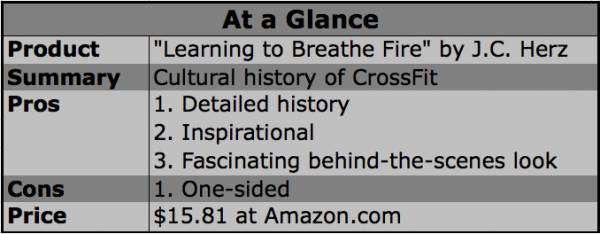
If you’re an athlete with a furious appetite for all things CrossFit, have I got a book for you. Even if you’re not a CrossFitter and want to learn more about the movement’s history, you’ll want to check out the book Learning to Breathe Fire, by J.C. Herz.
J.C. Herz was already a veteran writer before writing Learning to Breathe Fire. Having written for Rolling Stone, Wired, and the New York Times, Herz only needed to discover her love for CrossFit to turn her writing talents towards the fitness behemoth.
Unlike many other fitness books, Herz didn’t reinvent the wheel. When you’re writing about CrossFit, you can’t exactly list out the workouts of the day (WODs) or describe the exercises. There would be no point, as that’s all public information anyway. Instead, Hertz wrote an impassioned history of CrossFit’s landmark moments with a life and verve that CrossFitters will understand to their core, and non-CrossFitters will envy.
A Book for CrossFitters
It seems fairly obvious that this book will appeal to CrossFitters. If you’ve joined CrossFit as a part of the big wave of office workers, laborers, CEOs, and mail room clerks who have become CrossFit enthusiasts, learning the history of the culture that’s been taking ahold of you will no doubt be exhilarating. You can stand on the shoulders of giants, as it were.
For those who started CrossFit a half-decade ago or more, when the culture amounted to little more than posting your WOD scores on the otherwise spartan CrossFit website, this book may provide a bit of nostalgia for you. The diehards may love recounting some of the history they know, and learning some of the details that perhaps they didn’t.
Personally, I fit into a variation of the latter group, which I suspect is quite large. Being well-entrenched in the fitness world, I knew about CrossFit early on. I would peruse their website now and again, and try the workouts that I saw. At my level of experience, the workouts weren’t particularly new, but that’s not what kept me checking out the website time and time again. The forums where people posted their WOD scores were what kept me returning to the website.
Posting results on an online community isn’t new, either. Plenty of websites have done it since the dawn of the Internet, but the CrossFit website just felt different. It was an entity of its own. Its feel was remarkable and unmistakable. That was the burgeoning culture that made CrossFit special, and it’s exactly what Herz has a knack for describing. This book will be enjoyable to anyone who has thought about CrossFit more than once, for good or bad, simply because it has such a unique presence that can’t be explained by fitness alone.
About the Book
The story opens with Jerry Hill, an ex-Marine yearning for the feeling he would get during his toughest physical labors and the lengths he went to to get that feeling back. The book is full of personalities like Jerry, and it follows him and others as they weave through the path to becoming the juggernaut that CrossFit is today. From new coaches renting out space in dojos just to get a crew of enthusiasts inside, to the advent of the CrossFit Games, which became the biggest sporting event by participation in the world, and then on to big corporate sponsorship, this book covers a huge swath of the cultural history of CrossFit.
One of my favorite sections is about the CrossFit legend Rich Froning. His story interested me because he was a small-town guy working out in his family barn, which reminds me of my own childhood. No matter who you are, you will identify with one or many of the personalities that make the CrossFit culture as big as it is today.
CrossFit-Colored Glasses
The only possible downside is that Herz often portrays CrossFit as seen through CrossFit-colored glasses. There’s no question that Herz is a convert to the cult, as she herself calls CrossFit in the book. Even when potentially negative aspects of CrossFit culture are raised, such as founder Greg Glassman’s refusal to acknowledge other successful programs as useful for athletes, they get brushed off with the statement, “Things are better now.” If you’re not drinking the Kool-Aid, this might come across as distasteful.
As far as books go, this one is pretty much the CrossFit of books. At least some of it will be of interest to everyone, even if the haters can’t admit it. It’s a well-written and well-detailed rose-colored history of CrossFit and some of its many people. Learning to Breathe Fire is worth a read for anyone with an interest in CrossFit.
“Learning to Breathe Fire” is available for $25.00 at Amazon.com.






